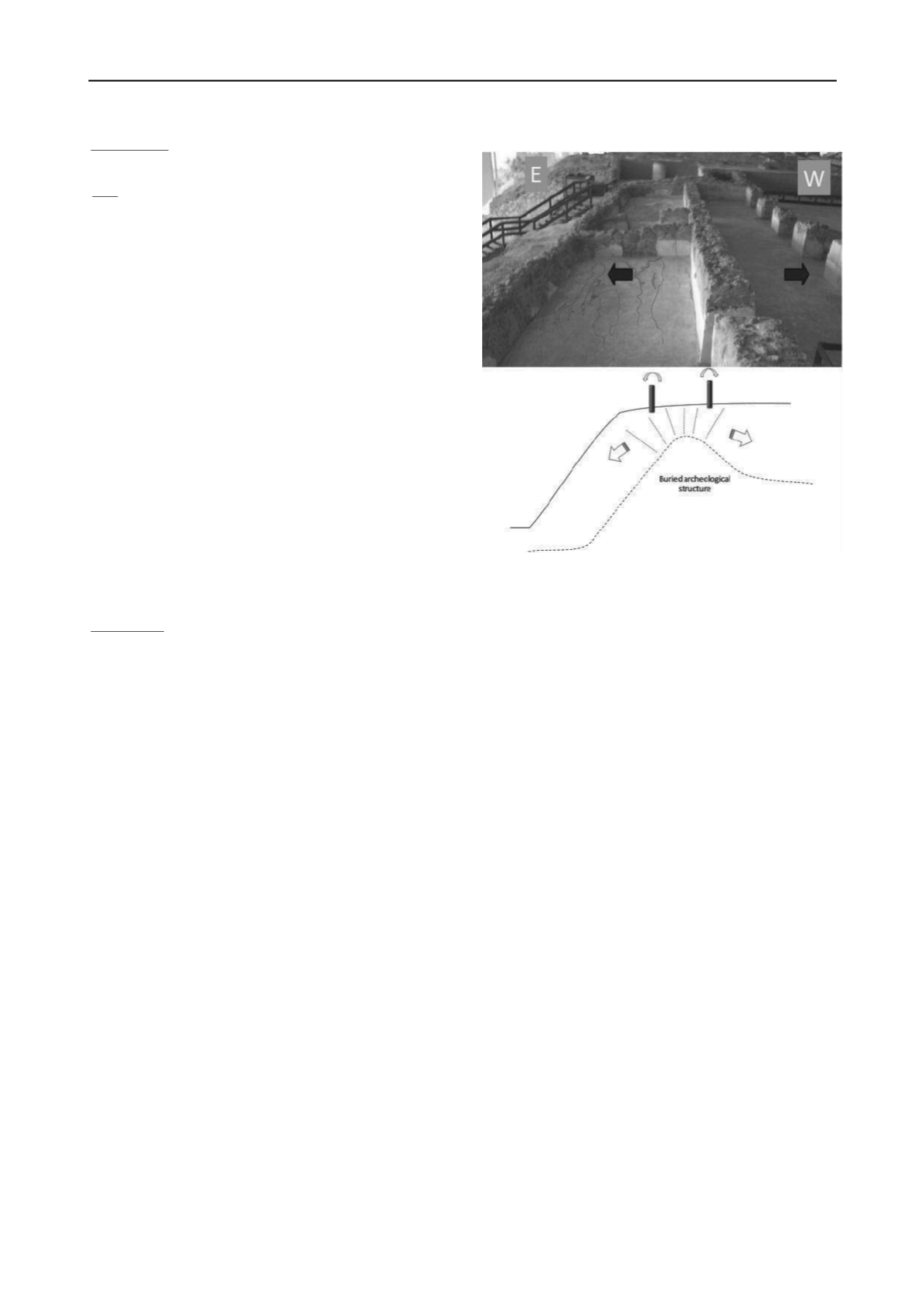
1573
Technical Committee 203 /
Comité technique 203
Proceedings of the 18
th
International Conference on Soil Mechanics and Geotechnical Engineering, Paris 2013
Organic soils
. Formed by loamy or silty soils with little sand
and organic material. Their thickness is variable, from 0.2 to
1m. They are located mainly in zones with small slope.
Fills
. They are materials deposited by man in different periods,
with different types of constructive processes and materials.
Mainly three types of fill are distinguished, named in terms of
their origin and quality: recent, pre-hispanic without structure,
and structured pre-hispanic. The first one is a silt of low
plasticity with variable contents of sand, or silty sands on
occasions with pre-hispanic scrap (sherds), roots and lenses of
sand or gravel, with or without compacting, used in the
construction of recent earth structures, such as the access
platforms and protecting structures, with or without
compacting. The pre-hispanic fill without structure is similar
to the first in composition, but more erosive, and was used by
pre-hispanic builders to finish the structures. This unit is
characterized by being formed by loose to lightly compacted
fills, with roots and voids, that on occasions form small
tunnels where animal activity takes place. In general, they
tend to be unstable in cuts, especially when the material
degrades or saturates. This fill can contain pre-hispanic
substructures, such as floors, walls, etc. Finally, the structured
pre-hispanic fill is formed by fragments of tuff packed in a
sandy loam or sandy silt matrix of low plasticity, with scarce
cementing. This fill lies below the previous two and was the
material used to over elevate the level of the natural terrain,
create new construction levels, and build walls or various
substructures, so its thickness is expected to be variable.
When this fill occurs with little cementing it is unstable, and
on occasions it presents local failures, such as chipping, which
can give rise to failures or general sliding.
Volcanic tuff
. It is a soft rock of light to dark brown color, on
occasions with caliche and pumice lenses. It presents a slight
semi-vertical fracturing and it is generally very stable in cuts,
and impermeable and easily excavated. Given the good
geotechnical quality of this unit, deep excavations are carried
out frequently with no stability problems. In the soil
mechanics study carried out by Diseño e Ingeniería Aplicada
(1985), the tuff was observed to be at an average 5m depth on
the periphery zone of the Gran Basamento.
Regarding the conditions of subterranean water, the phreatic
water level is deep and there only are superficial leaks due to
rain, or due to condensation water stored on the metal roofing,
or due to leaks from the collection system.
4 SUPERFICIAL CRACKING AND PLATFORM
MOVEMENTS
Based on a general mapping of superficial cracks (Rangel,
et al
,
2006, and Mooser 2005) and the geotechnical model, the
position of the cracks is observed to be essentially peripheral,
which indicates that they are linked directly to the Gran
Basamento
’s slopes; also, cracking is produced toward the
platform
’s central part (Fig 6).
The above suggests that under the central portion of the
cracks and at some depth, there must be a local high, meaning a
mound, or buried structures, which possibly form the
monument’s original base. This aspect is reinforced upon noting
that the archeological wall is tilted toward the eastern slope.
Analyzing various points, one can also note that the
arrangement of the cracks often produces the formation of tiny
pits and pillars that reveal a superficial state of tension.
There is another cracking system that develops in a concentric
manner around columns or walls. This cracking is genetically
associated to the subsidence of the structures (walls, columns,
etc.) due to a deficiency in the supporting material’s
compacting. According to what was observed, this subsidence
developed mainly during the construction of the pre-hispanic
structures.
Figure 6 Cracking near slopes
The cracking observed is the result of the internal movement
and rearrangement of the Gran Basamento. Although the
movements are barely perceptible, with time they can generate
important instability zones. In general, three types of movement
of the Gran Basamento were observed (Rangel
et al
2006), as
follows: subsidence, lateral displacement, and a combination of
both.
The subsidence observed originates from the presence of
loose fills placed by the ancient inhabitants where structures
rest, whereas the lateral displacements are mainly due to the
subsoil’s small shear resistance at the point of contact between
the badly compacted fill and the compact or natural soil; any
change in the slope, whether by doing a cut or applying a
surface overload, causes the fill to slide along that frontier.
At the lower part of the platform the trees are seen to be
slightly tilted, which suggests the existence of a slow
displacement process or creep, associated to the excessive
humidity that exists at the point of contact between the badly
compacted fill and the natural terrain. This aspect was only
observed at the fill zone, mainly the pre-hispanic one without
structure.
The creep mechanism, the lateral displacement and the
subsidence can locally cause mechanisms of rotational failure
during their stages of great development.
There is cracking that is active, such as in Building A, the
temple of Venus, the Red Temple, and the South Portico. This
cracking i
s the product of the slope’s instability, except for the
Red Temple, whose causes are nearby excavations and soil
altering processes.
Currently the active factors that importantly influence the
generation of cracking are: excessive inclination of the slopes,
subsoil increase of water content (infiltrations), excavations,
abrupt temperature changes, overloads, vibration, and
progressive soil alteration.
5 GEOTECHNICAL ANALYSES
In order to evaluate stability conditions on the Gran
Basamento
’s northeastern slo
pe, at the zone of Building A,
where there has been important cracking, and also to know the


